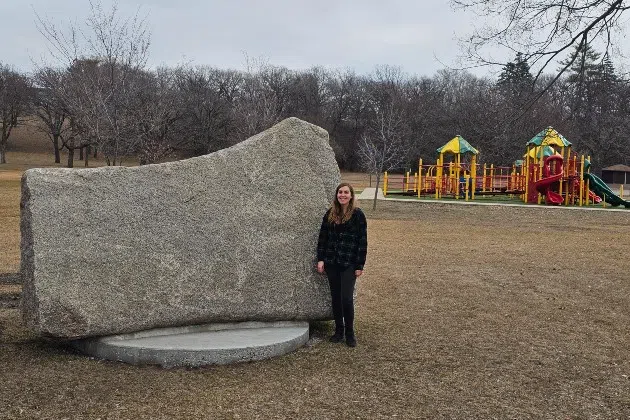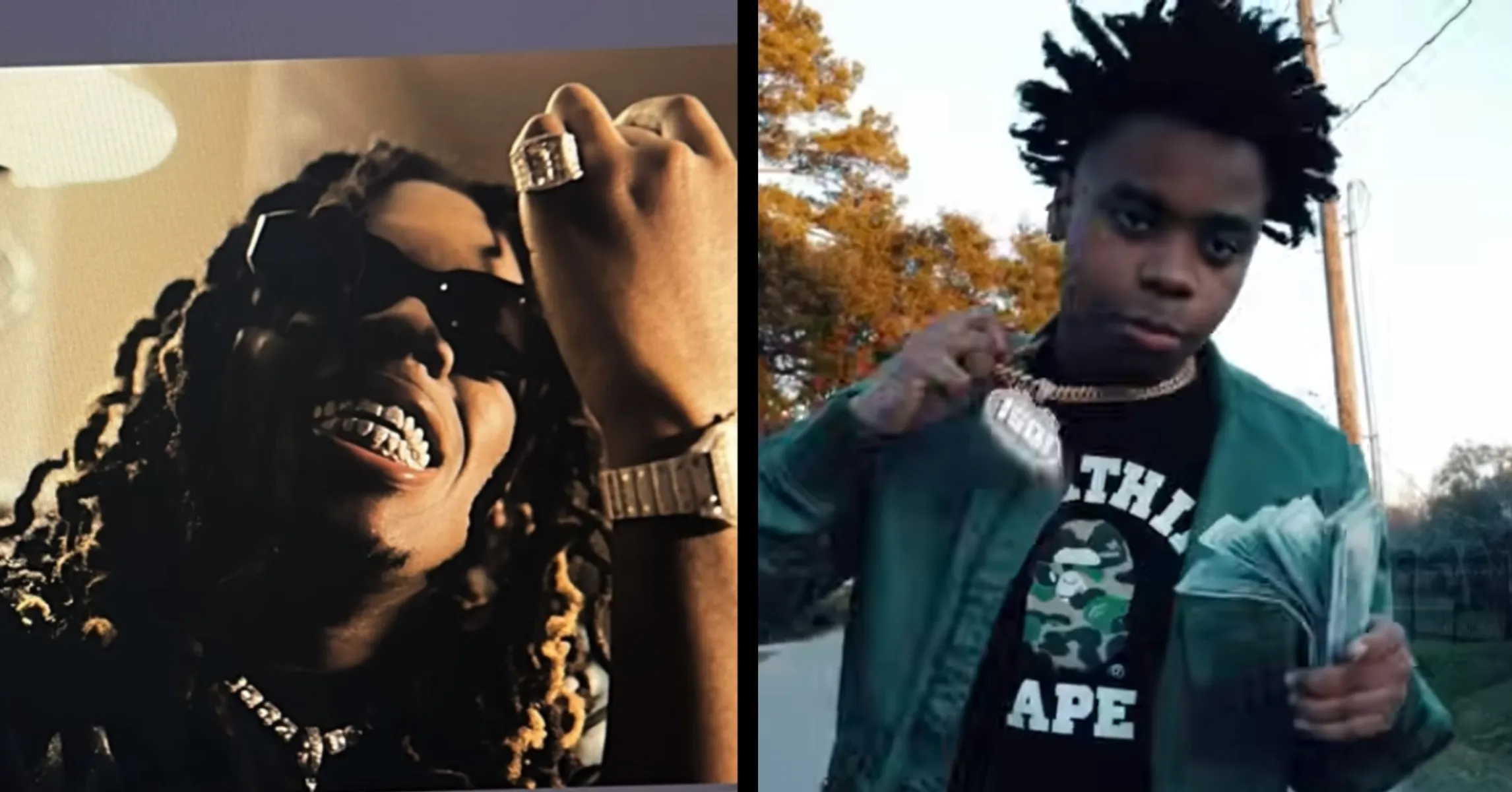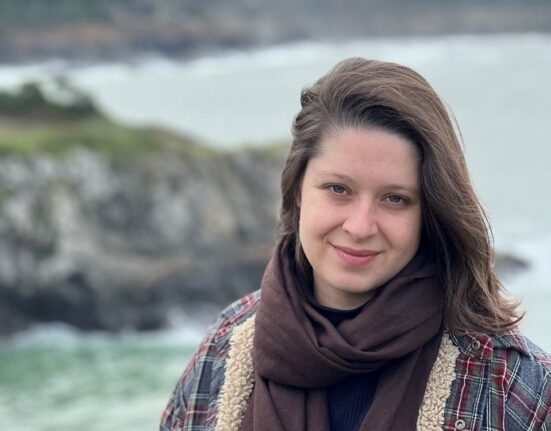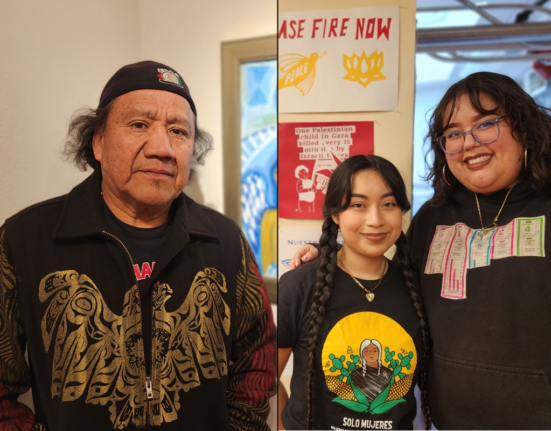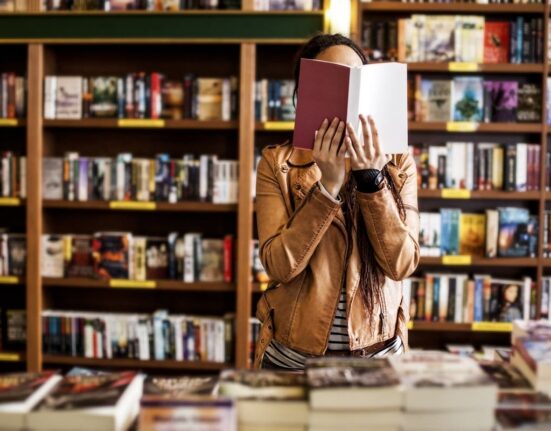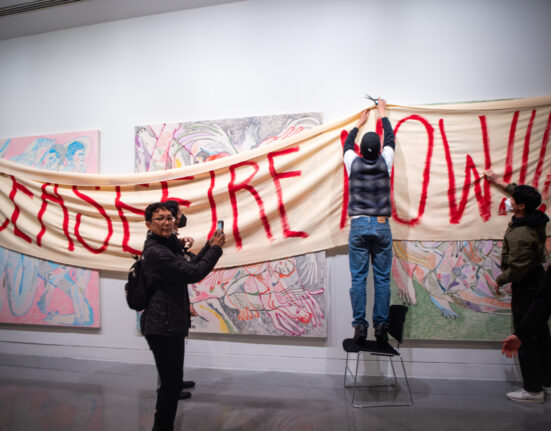Look, you’re probably not headed to Intuit Dome just to see the artwork. First and foremost, the soon-to-open Inglewood arena will be the home of the Los Angeles Clippers when the NBA season starts in the fall. And even before it’s time for basketball, the 17,700-plus-seat venue will welcome concertgoers, starting with Bruno Mars in August.
But don’t be surprised if you come away from your first visit with just as many photos of the art as the event. That’s because the Clippers have assembled an all-star team of L.A. and Inglewood artists to craft site-specific installations for its new home, which Gillian Zucker, president of business operations for the Clippers, calls a basketball palazzo, music mecca and urban oasis.
We were invited this week to preview the first half-dozen installations to be unveiled at Intuit Dome, including works by Refik Anadol, Glenn Kaino, Patrick Martinez, Michael Massenburg, Kyungmi Shin and Jennifer Steinkamp.
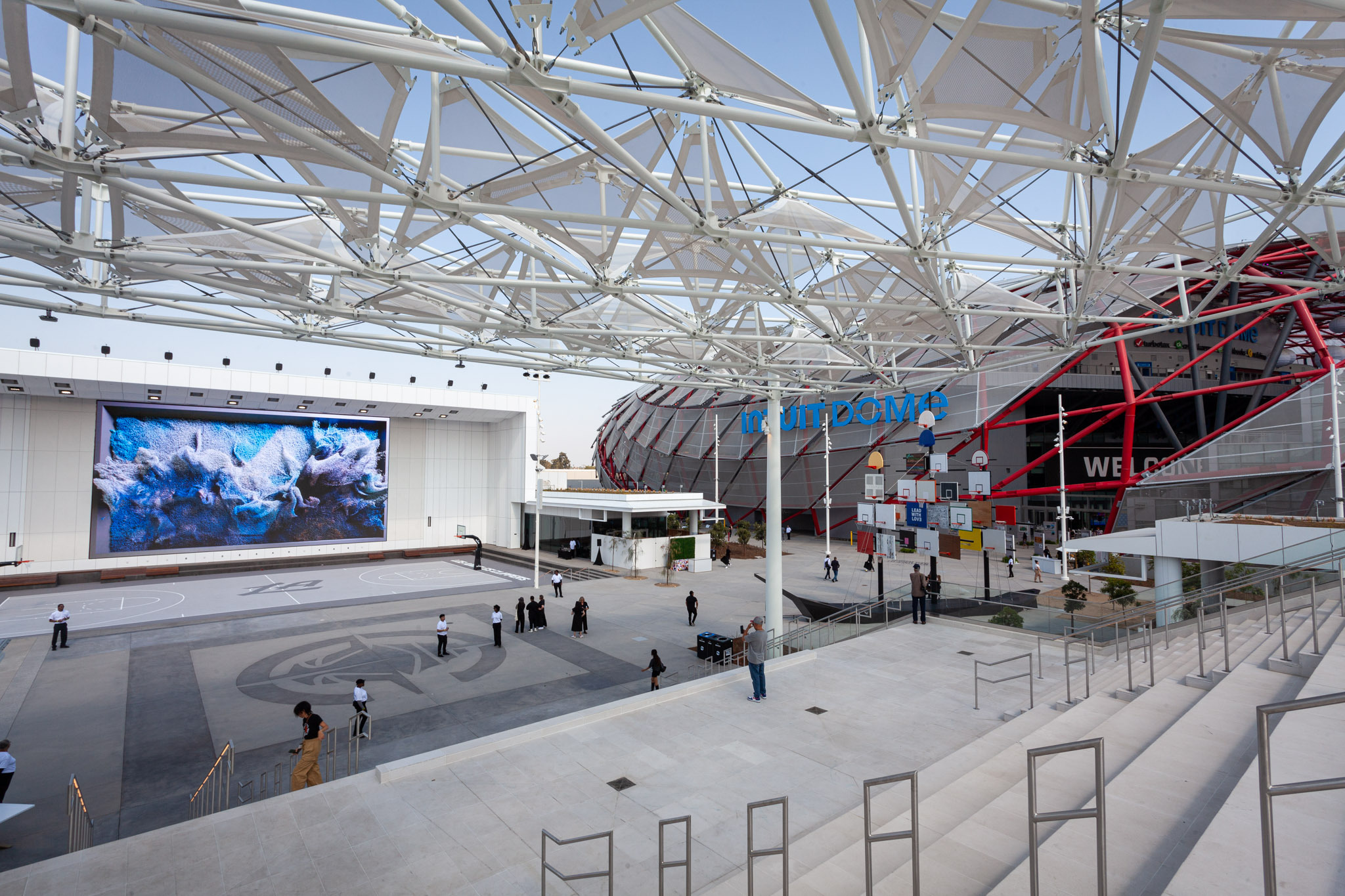
As the arena’s art consultant Ruth Berson explains, the team didn’t solicit proposals for its pieces but instead specifically approached all of these artists for their commissions (after being selected from a shortlist hatched by museum curators, art historians and the local arts community). After three years of discussion, planning, fabrication and installation, the resulting pieces manage to, in our opinion, successfully accomplish something seemingly pretty tricky: to create large-scale installations that are both obviously inspired by basketball but also function on their own as pieces of fine art, while still acting as photo-friendly decor for folks who are just there to see a game or concert.
There were a handful of forthcoming installations that weren’t quite ready to be shown off, including fashionable portraits of Clippers players from photographer Glen Luchford that’ll be installed inside; an exhibition of photographs of the community by Catherine Opie, on loan from MOCA; City Edition jerseys and a court design by Jonas Wood; and a still-to-be-unveiled piece from Charles Gaines. And though Walter J. Hood handled the landscape design of the campus, some areas were still fenced off for construction during our visit.
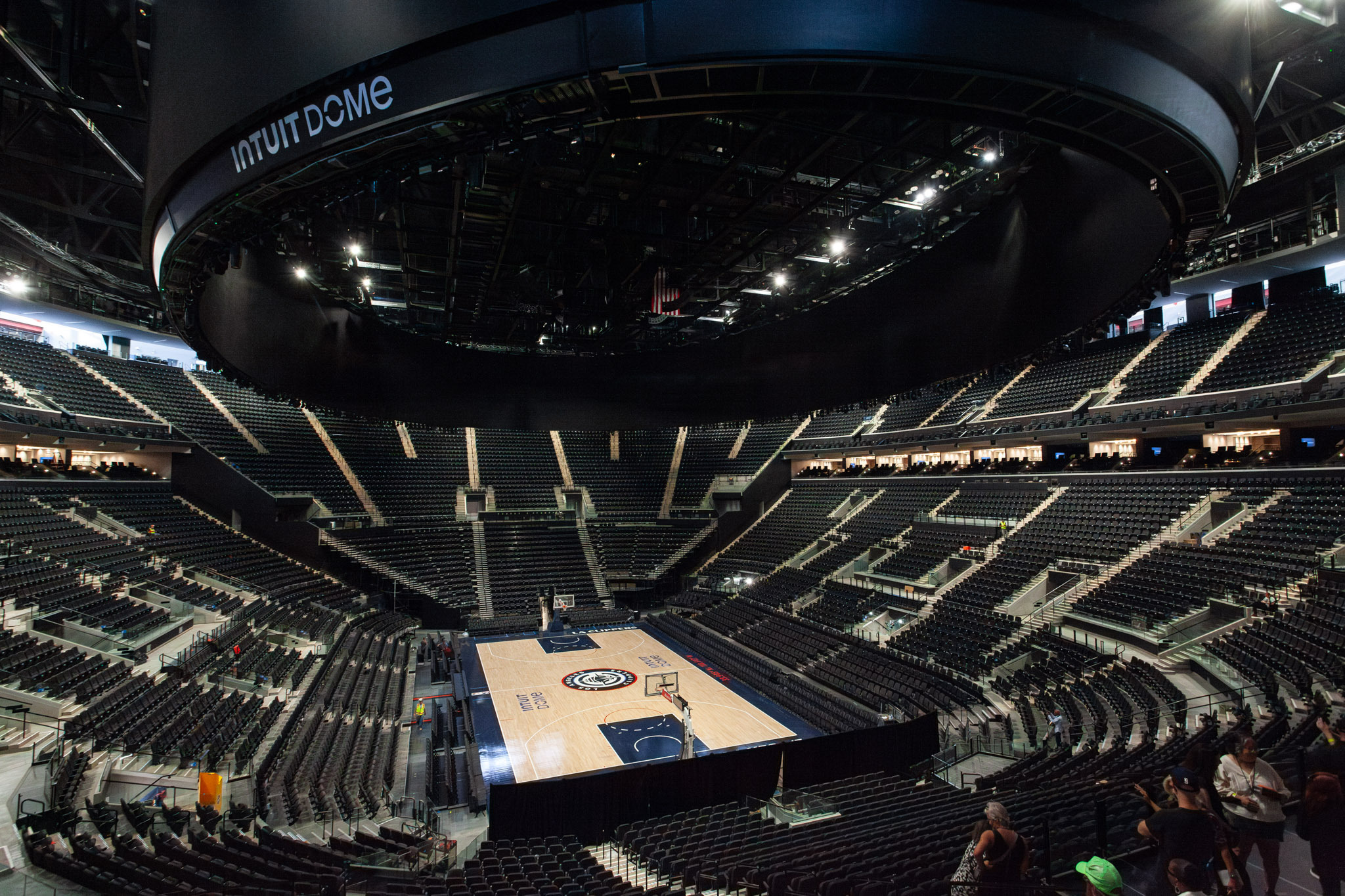
Also, while we did briefly step inside the court area of the dome, we didn’t get a full tour of the entire building. But that was still enough for some quick thoughts: The sightlines from the bowl-shaped seating seem pretty excellent, the slick wrap-around scoreboard looks like the one at the neighboring SoFi Stadium just resized for an arena, and the color-changing lights installed in the armrests of every single seat—which we saw being tested for just a few seconds—should be sure to dazzle.
With all that in mind, here’s a rundown of the major art installations at Intuit Dome.
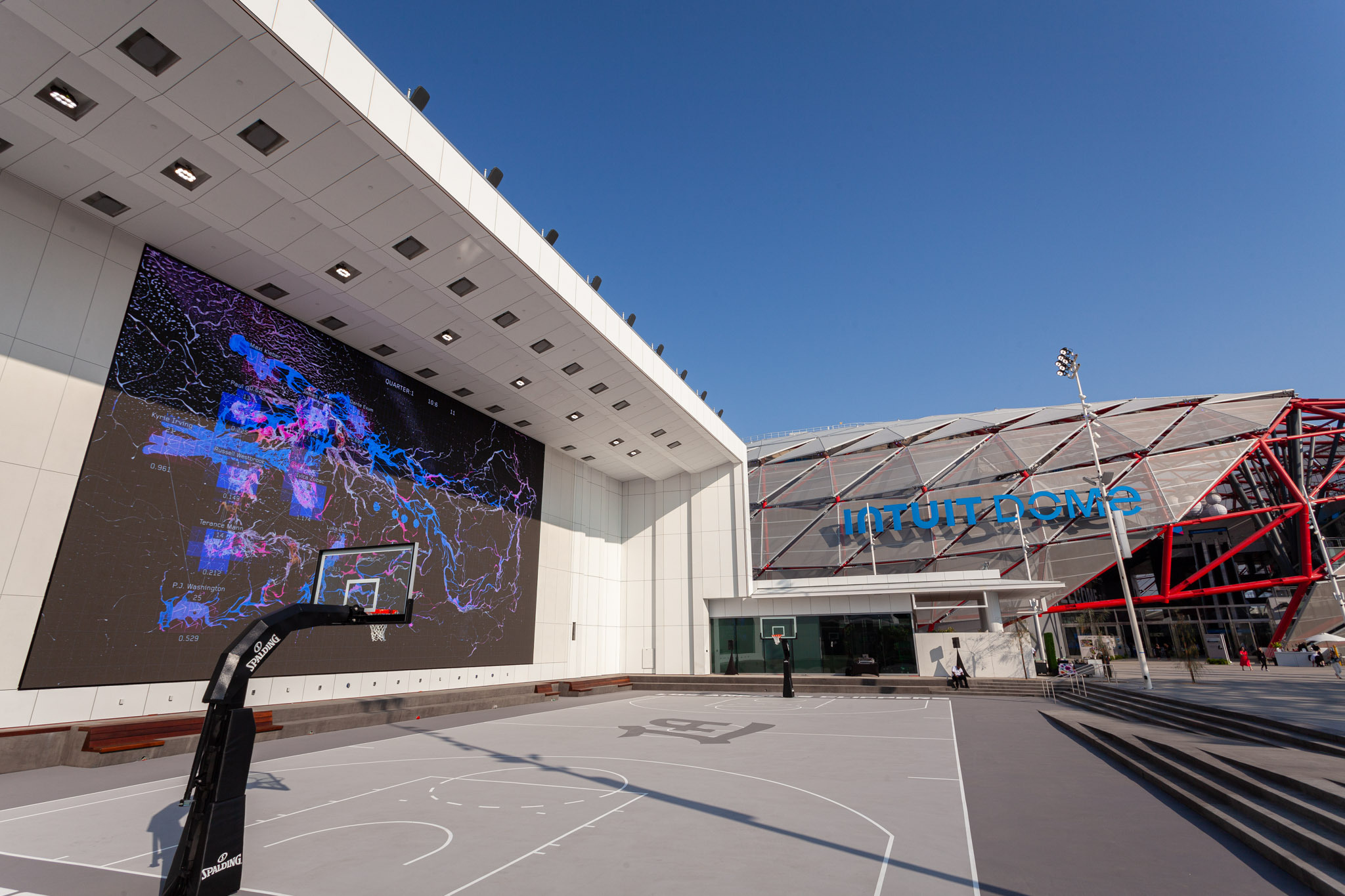
Refik Anadol, Living Arena
Whether you enter from the parking garage or the street, this 40-foot-tall, 70-foot-wide LED screen is unmissable—and will undoubtedly become the backdrop, intentional or otherwise, for the flood of photos and videos that hit social media from Intuit Dome events.
Set against a functional community basketball court, Refik Anadol’s video installation should look familiar to those who’ve spotted his crowd-pleasing pieces in galleries or projected onto the side of the Walt Disney Concert Hall: The artist uses AI to crunch real-time data into glowing infographics and trippy, wave-like visualizations. At Intuit Dome, you’ll spot four-minute chapters that feature splashing particles driven by live weather conditions, flight info that aligns with the LAX-bound planes that pass overheard every couple of minutes, and paint-like streaks that follow player movements from historic Clippers games (during our visit, we were able to watch data point versions of Russell Westbrook and James Harden zip around the court in the first quarter of an old game against the Mavericks).
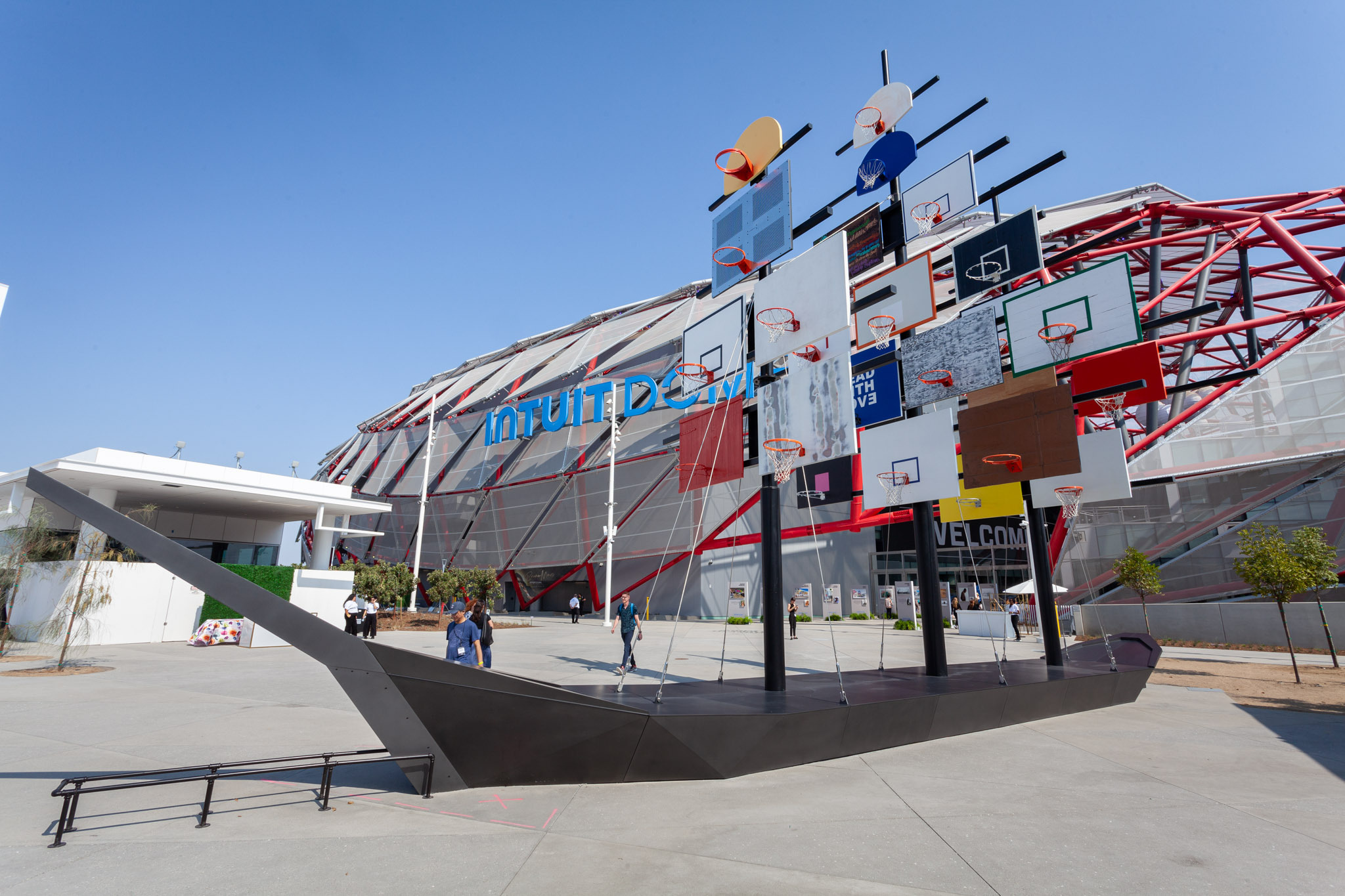
Glenn Kaino, Sails
Playful, pensive and the most explicit tie-in to the team’s new clipper ship logo of all the installations, Glenn Kaino’s plaza sculpture replaces a boat’s sails with backboards and hoops inspired by ones from around the globe.
Kaino says that as his practice has brought him all over the planet, he’s found himself taking photos of basketball courts and noting how different they can look from place to place. For Sails, some of the backboards are a pastiche of multiple styles, while others are a nearly one-to-one recreation of specific courts Kaino has seen: A red barn door references one in Oregon, while a spartan one visually pulls from the Manzanar War Relocation Center, where Japanese-American citizens—including Kaino’s ancestors—were incarcerated during World War II.
Altogether, the sculpture speaks to both fun and resilience—“a clipper ship where basketball was the wind behind the cultural sails”—and the power of both art and sports to connect people. “The fact that they all look different, they all have different textures, but we all play the same game is something super powerful,” Kaino says.
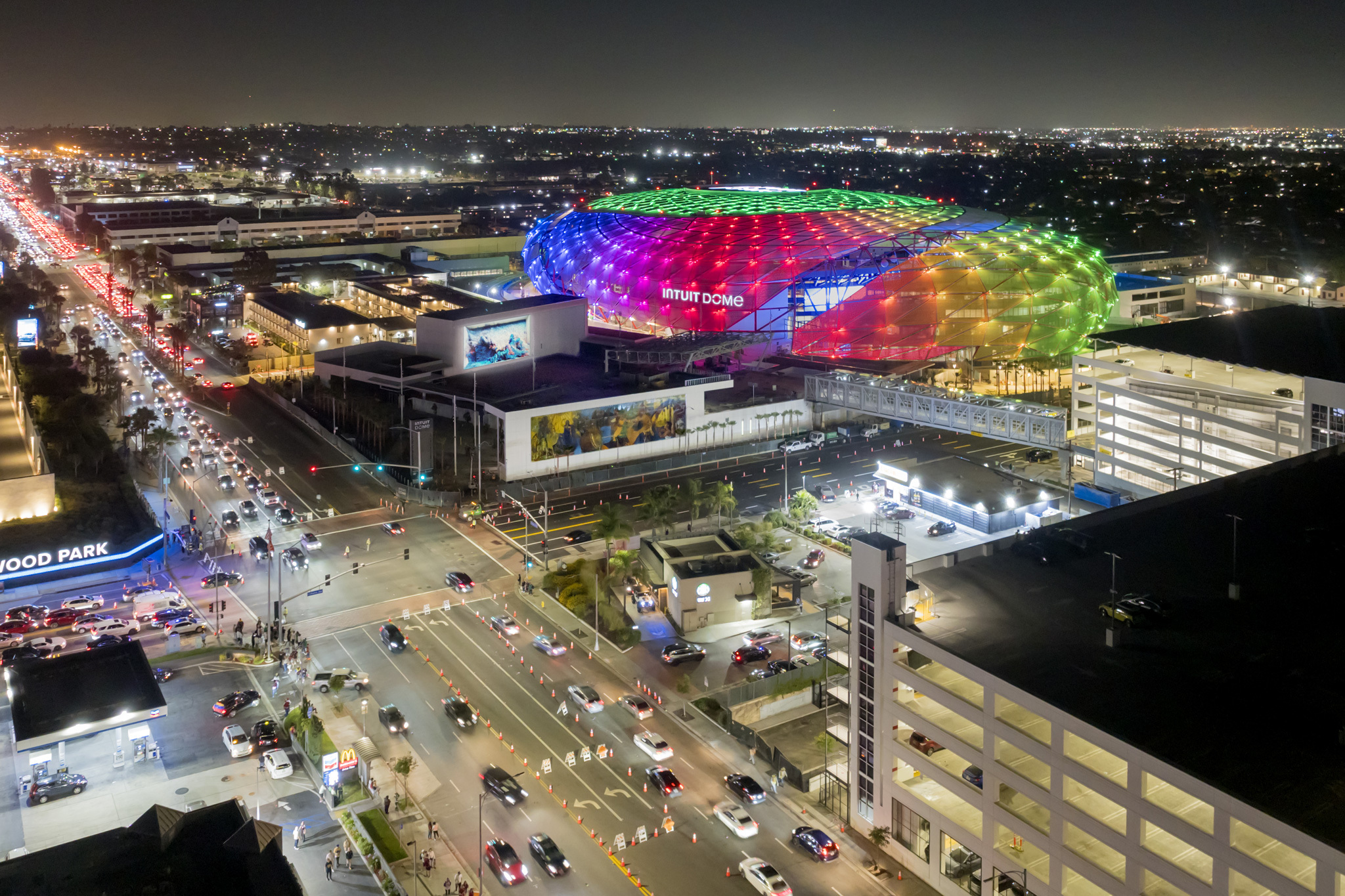
Jennifer Steinkamp, Swoosh
The only installed installation we didn’t get to properly see was oddly enough the arena’s largest: The Illuminated facets that spiral around the arena’s net-like exterior are actually part of one giant piece by Jennifer Steinkamp, who’s created five lightning programs that swoosh toward the hoop-inspired center of the dome’s shell. Our preview concluded well before sunset, so the lights were just barely visible, but you can expect to see some pretty vibrant hues in the evening.
Steinkamp typically works in video—she actually created a piece for the Staples Center’s opening in 1999, an installation underneath the sharp point of the roof that overlooks Chick Hearn Court—and she considers this lighting program to be a video piece, as her 2-D creations were mapped onto the dome’s light sources like a Mercator projection. She started to translate her videos to the dome’s exterior by first using VR and then employing drones from the top of the parking garage across the street.
“I guess I could have, you know, flown in and out from LAX and looked at it as well,” Steinkamp jokes. “Actually, that’s probably going to be the best view.”
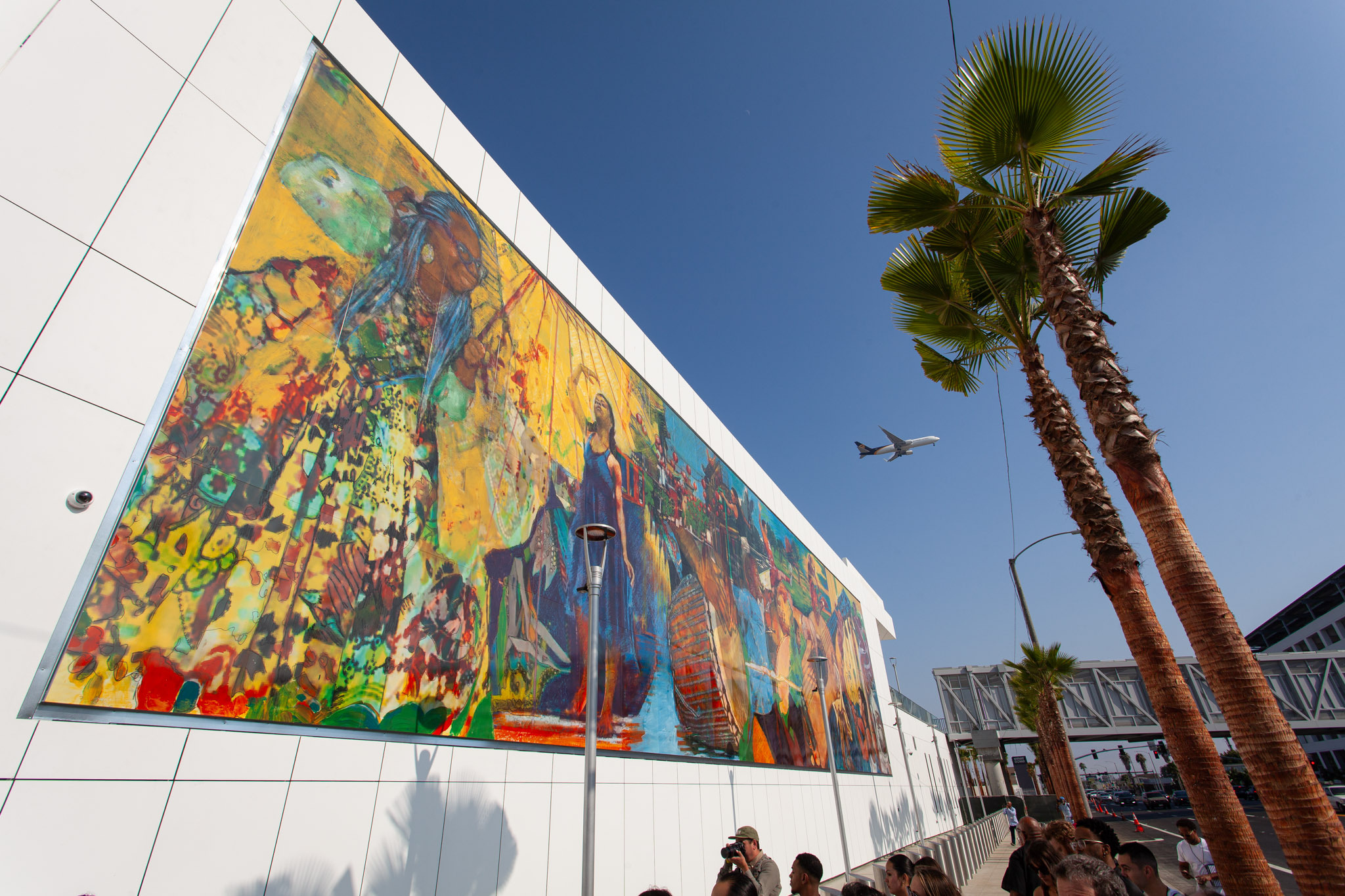
Michael Massenburg, Cultural Playground
The easiest-to-spot piece from outside the arena, Michael Massenburg’s porcelain enamel mural of sports and cultural scenes stretches 100 feet along Prairie Avenue. Guitar strings are strummed and soccer balls kicked next to depictions of Inglewood’s Fox Theatre and the red lanterns of Chinatown Central Plaza.
“I wanted to create something that was going to bring all the different communities together because L.A. itself is one of the most diverse cities in the world, where we don’t act like it at times,” Massenburg says, adding that he hopes the familiarity of figures in his work can defuse some of the freeway-crossing, rush hour stress from drivers stuck at the adjacent traffic light.
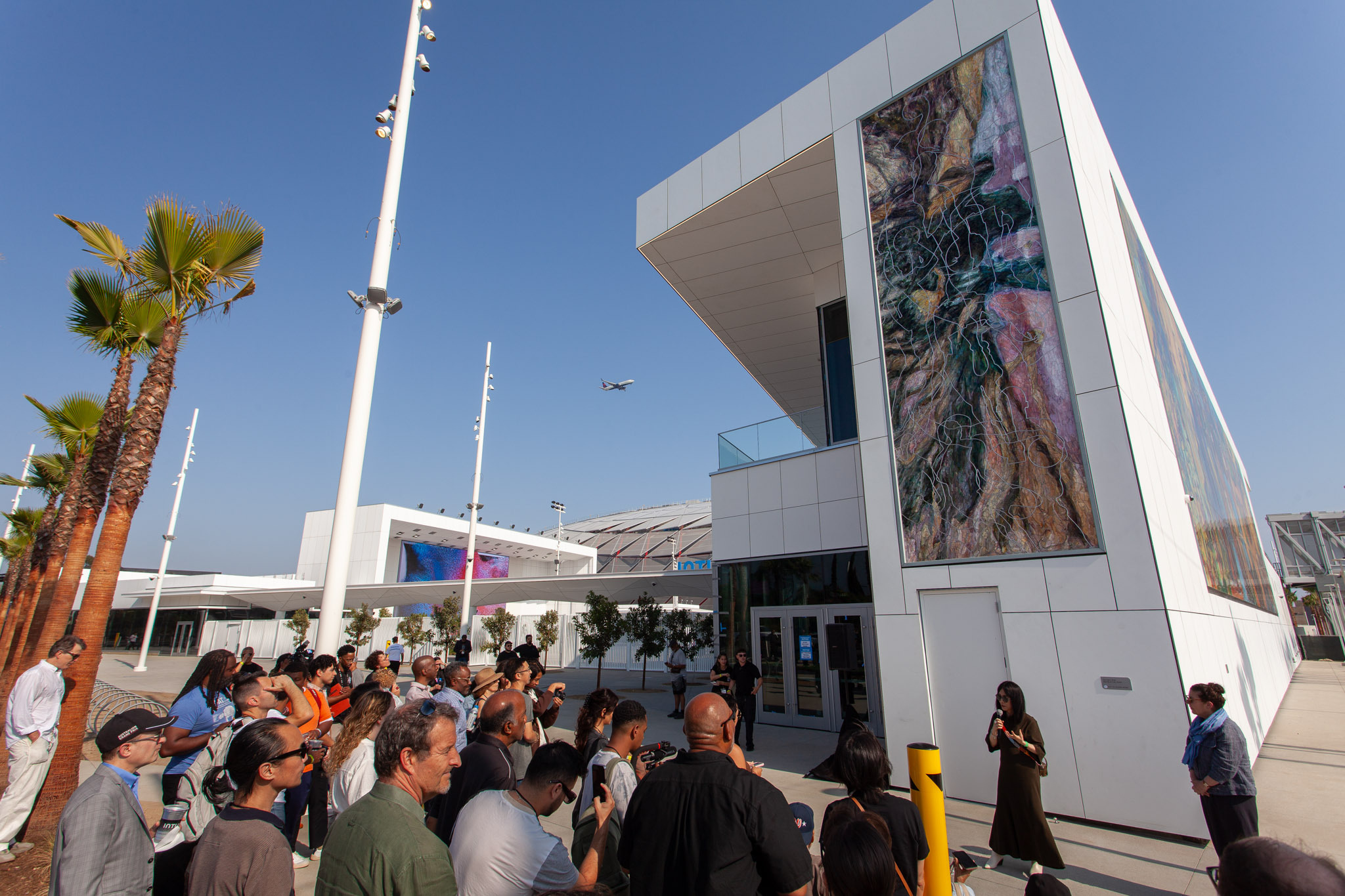
Kyungmi Shin, Spring to Life
Over on the Century Boulevard side of the street corner, Kyungmi Shin’s 22.75-foot-tall stained glass mosaic overlays washes of cool watercolors with steel outlines of basketball players in familiar poses (think: dunks, jump shots and the instantly recognizable silhouette of the Jerry West-inspired NBA logo).
For all the ball-bounciness of it, though, the piece actually mostly takes its inspiration from the now-tapped-out Centinela Springs, an essential water source in the area for the Tongva people that Shin first encountered on an old poster at the Huntington that boasted about Inglewood’s natural springs.
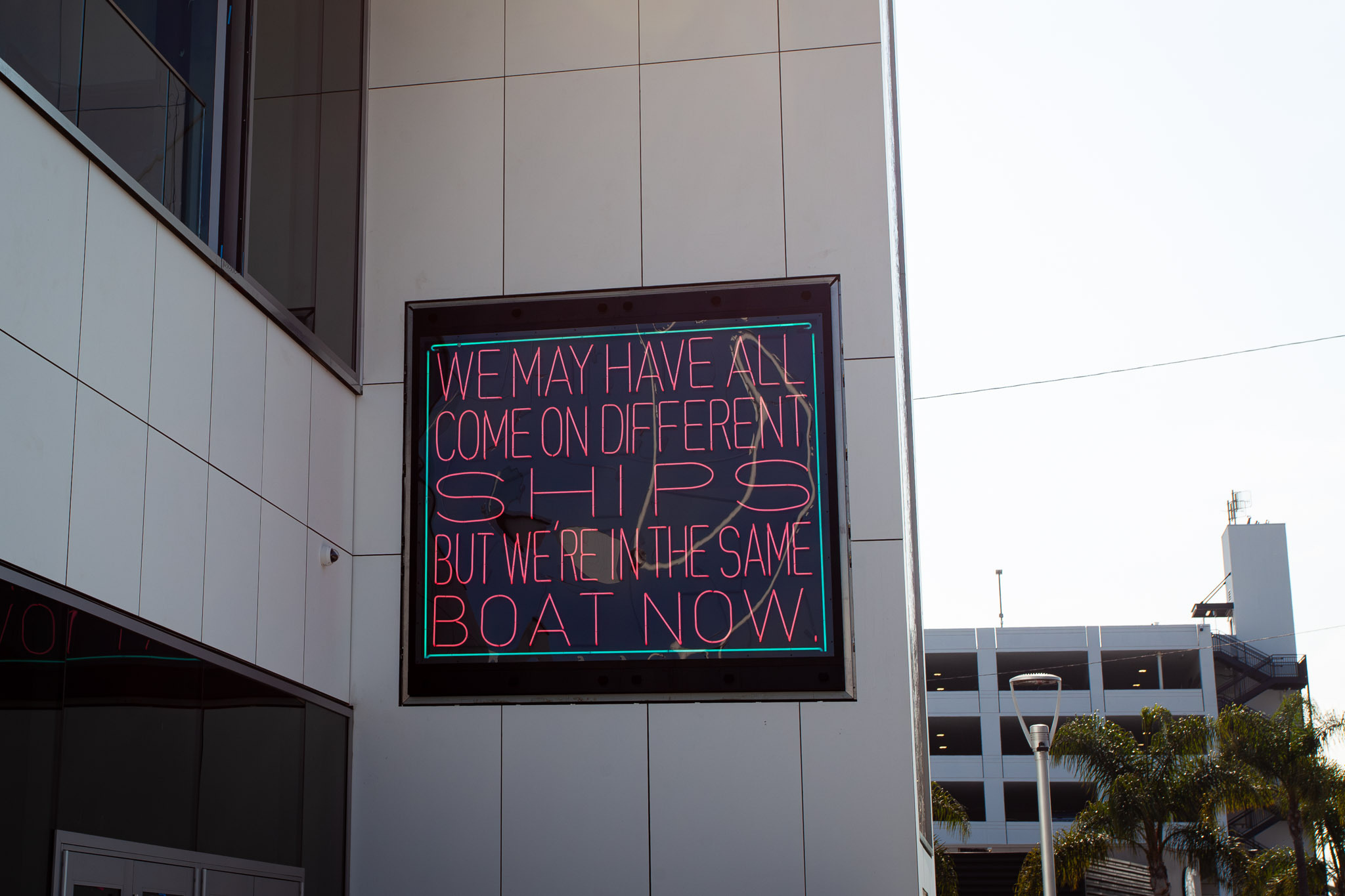
Patrick Martinez, Same Boat
On the narrow well right next to Spring to Life, you’ll find this neon sign by Patrick Martinez, who first fell in love with the artform after many nighttime drives past laundromats and various other businesses where the Sixth Street Viaduct turns into Whittier Boulevard.
The piece’s quote—“We may have all come on different ships but we’re in the same boat now”—is often attributed to Martin Luther King Jr., but the arts team at the arena found that it can actually be traced back to civil rights leader Whitney M. Young. Martinez actually first employed the quote in a politically-inspired piece in 2017, but here it’s been repurposed in a setting that brings sports fans together (and with a clear nod to the team’s sailing ship-inspired name).
“I wanted to populate spaces with messages that re-energize people,” Martinez says. “Messages from the past, and reestablishing those messages in a new way.”


